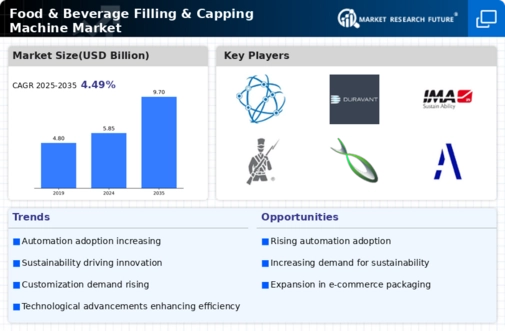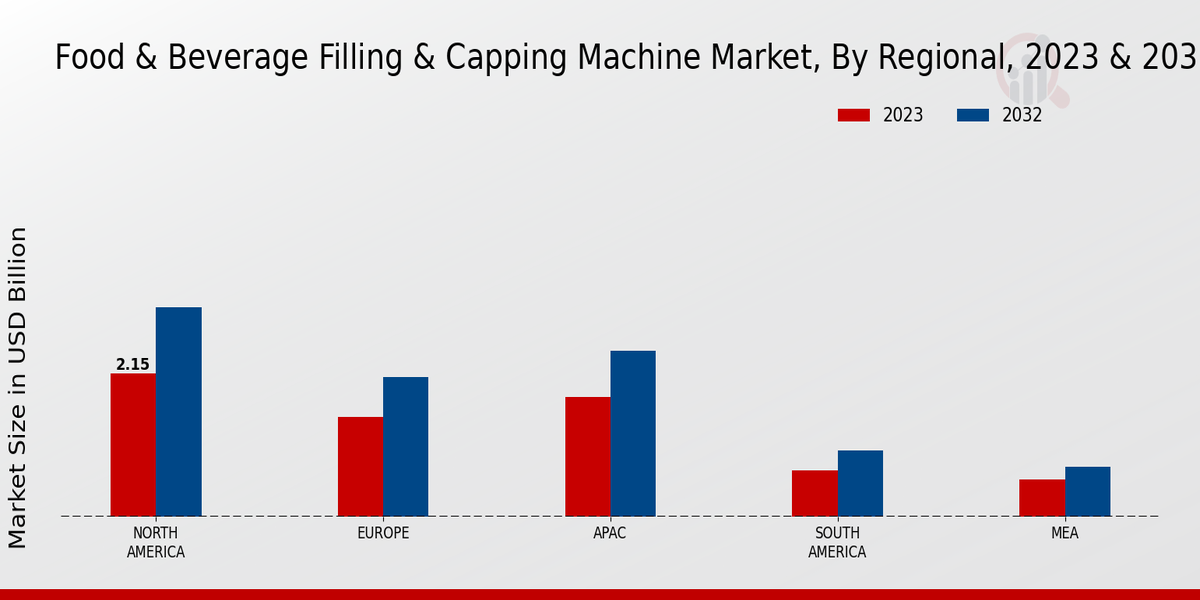Market Growth Projections
The Global Food and Beverage Filling and Capping Machine Market Industry is poised for substantial growth, with projections indicating a market value of 5.85 USD Billion in 2024 and an expected increase to 9.7 USD Billion by 2035. This growth trajectory underscores the increasing demand for efficient and reliable filling and capping solutions across various segments, including dairy, beverages, and packaged foods. The anticipated compound annual growth rate of 4.7% from 2025 to 2035 reflects the industry's response to evolving consumer preferences and technological advancements, positioning it for a dynamic future.
Sustainability Initiatives
Sustainability is becoming a crucial driver in the Global Food and Beverage Filling and Capping Machine Market Industry. Companies are increasingly adopting eco-friendly practices, including the use of recyclable materials and energy-efficient machinery. This shift is not only a response to consumer demand for sustainable products but also aligns with regulatory pressures aimed at reducing environmental impact. As businesses strive to enhance their sustainability profiles, the demand for filling and capping machines that support these initiatives is likely to rise. This trend could further accelerate market growth as companies seek to innovate while adhering to environmental standards.
Technological Advancements
Technological innovations play a pivotal role in the Global Food and Beverage Filling and Capping Machine Market Industry. Automation and smart technologies enhance production efficiency and reduce operational costs. For instance, the integration of IoT and AI in filling and capping machines allows for real-time monitoring and predictive maintenance, which can minimize downtime. As a result, manufacturers are increasingly investing in advanced machinery to stay competitive. This trend is likely to contribute to a compound annual growth rate of 4.7% from 2025 to 2035, indicating a robust shift towards more sophisticated production processes.
Consumer Health Consciousness
The rising health consciousness among consumers is a notable driver in the Global Food and Beverage Filling and Capping Machine Market Industry. As individuals become more aware of nutritional information and ingredient sourcing, there is a growing demand for healthier food and beverage options. This trend compels manufacturers to innovate their product lines, requiring advanced filling and capping technologies that can handle a variety of formulations, including organic and functional foods. The market's anticipated growth, with a CAGR of 4.7% from 2025 to 2035, suggests that companies will increasingly invest in machinery that supports the production of health-oriented products.
Rising Demand for Packaged Foods
The Global Food and Beverage Filling and Capping Machine Market Industry experiences a surge in demand for packaged foods, driven by changing consumer lifestyles and preferences. As urbanization increases, consumers seek convenience, leading to a higher consumption of ready-to-eat meals and beverages. This trend is reflected in the market's projected growth, with an estimated value of 5.85 USD Billion in 2024, expected to reach 9.7 USD Billion by 2035. The need for efficient filling and capping solutions is paramount, as manufacturers strive to meet the growing demand while ensuring product quality and safety.
Growth of E-commerce in Food and Beverage Sector
The expansion of e-commerce in the food and beverage sector significantly influences the Global Food and Beverage Filling and Capping Machine Market Industry. As online shopping becomes more prevalent, manufacturers are compelled to adapt their packaging solutions to meet the unique requirements of e-commerce, such as durability and tamper-proof features. This shift necessitates advanced filling and capping technologies that can accommodate diverse packaging formats. The market's growth trajectory, projected to reach 9.7 USD Billion by 2035, reflects the increasing need for efficient packaging solutions that cater to the evolving landscape of food and beverage distribution.











